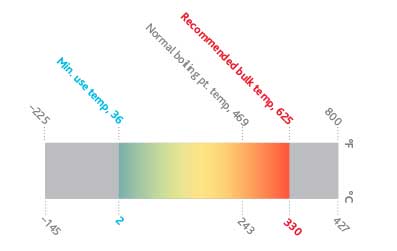Why Warmth Transfer Liquid Is Very Important for Optimizing Power Transfer in Equipment
The function of heat transfer fluids in enhancing energy transfer is critical for accomplishing efficient thermal management across numerous commercial fields. These liquids promote smooth warmth exchange, making sure procedures run within optimum temperature level varieties and alleviating the danger of overheating.

Role in Thermal Administration
Warm transfer fluids play an important duty in thermal monitoring by effectively managing temperature levels in different industrial processes and systems. These specialized fluids help with the transfer of warm between different components, guaranteeing optimal operating conditions and preventing overheating. By keeping precise temperature level control, warm transfer fluids enable industries such as chemical production, oil and gas, and power generation to run safely and effectively.
The option of an appropriate warmth transfer liquid depends on numerous variables, consisting of thermal stability, warm ability, and thickness. High thermal stability ensures that the liquid can stand up to extreme temperatures without weakening, while a high warm ability enables it to take in and launch considerable quantities of heat - heat transfer fluid. Reduced thickness minimizes the power needed for pumping, adding to overall system efficiency
In addition, warm transfer liquids are essential in applications like refrigeration, where they aid take in and dissipate warmth during the cooling cycle. In solar thermal power systems, these fluids capture and transportation solar heat to produce electrical energy or provide warm water. Their adaptability to varied operating problems and capability to keep constant thermal efficiency underscore their relevance in industrial thermal administration, facilitating functional connection and enhancing precaution.

Enhancing System Performance
To maximize the benefits of thermal administration, improving system performance via the strategic use of warmth transfer liquids is critical. By preserving ideal temperature level degrees, warm transfer liquids assist make certain that systems operate within their designed parameters, thus stopping getting too hot and lowering the threat of part failure.

Sorts Of Heat Transfer Fluids
The variety of warmth transfer liquids emphasizes their important function in a variety of industrial applications, each tailored to meet specific thermal management needs. These company website liquids assist in reliable power transfer and are picked based upon essential residential properties such as thermal stability, viscosity, and heat capacity. The key kinds include water, glycol remedies, oils, and synthetics, each offering distinctive advantages.
Water is one of the most usual warm transfer medium as a result of its high certain warm capacity and affordable. Its use is restricted by its freezing and steaming factors. Glycol mixes, frequently used in heating and cooling systems, provide click this site a reduced cold factor, including convenience in various climates. Mineral oils are favored for their thermal security and non-corrosive nature, making them ideal for high-temperature applications.

These fluids guarantee exceptional efficiency in systems where standard fluids may stop working. The choice of a warm transfer fluid is important, as it affects system effectiveness, safety and security, and long life.
Environmental and Economic Perks
Making use of the appropriate warmth transfer liquids uses considerable environmental and economic advantages for industrial procedures. By picking liquids with remarkable thermal security and high warm capacity, industries can boost power effectiveness, resulting in reduced fuel intake and reduced greenhouse gas discharges. This adds to a smaller sized carbon impact and lines up with worldwide sustainability goals. Eco-friendly warmth transfer liquids, commonly naturally degradable and non-toxic, minimize the threat of dirt and water contamination in the event of leakages or spills, thereby securing communities and adhering to rigorous environmental regulations.
Financially, the ideal warm transfer fluid can dramatically reduce operational prices. Liquids with extensive lifecycle efficiency reduce the frequency of substitutes and upkeep, lowering downtime and associated costs. Overall, the strategic usage of ideal heat transfer fluids sustains lasting economic development and environmental stewardship.
Selecting the Right Fluid
Just how does one navigate the intricate process of picking the ideal heat transfer liquid for commercial applications? Picking the suitable fluid is critical, as it straight influences system effectiveness, safety, and functional costs. Secret factors to consider include thermal security, compatibility with system materials, and running temperature array. Thermal stability makes certain the fluid can stand up to heats without deteriorating, while compatibility stops rust or various other harmful here are the findings responses with system components. The operating temperature level array should straighten with the system's requirements to maintain performance and long life - heat transfer fluid.
Additionally, the fluid's warm capability and thickness are extremely important. A high heat capacity allows the fluid to take in and move more power, boosting performance. Ideal thickness makes sure marginal pump job and reliable heat transfer, especially in varying temperature levels. Environmental and safety and security aspects should also belong to the decision-making process. Non-toxic, naturally degradable liquids minimize ecological effect and adhere to regulative requirements, reducing obligation dangers.
Verdict
The calculated selection and application of warm transfer liquids are essential to maximizing power transfer throughout various systems. By making certain high thermal stability and ability, these fluids supply precise temperature level control and enhance total system efficiency.
Comments on “A Comprehensive Overview to Heat Transfer Fluid for Solar Thermal Systems”